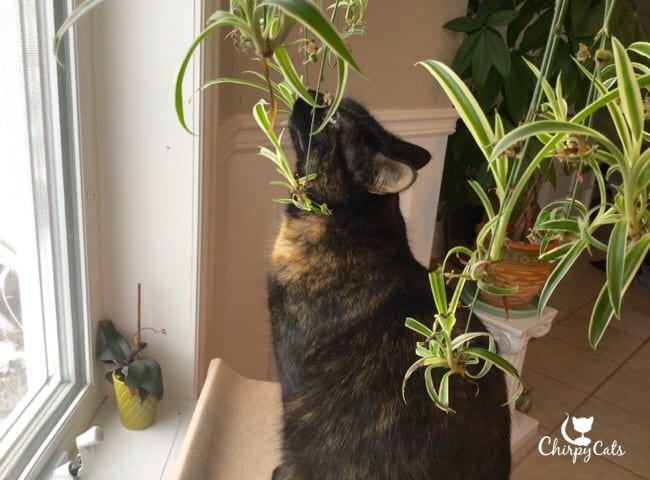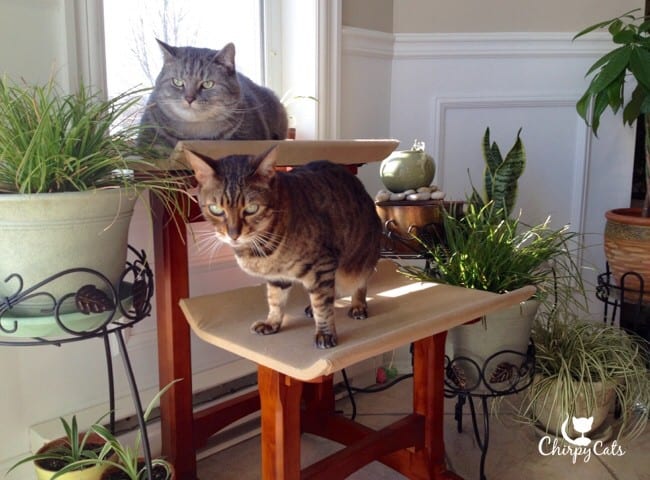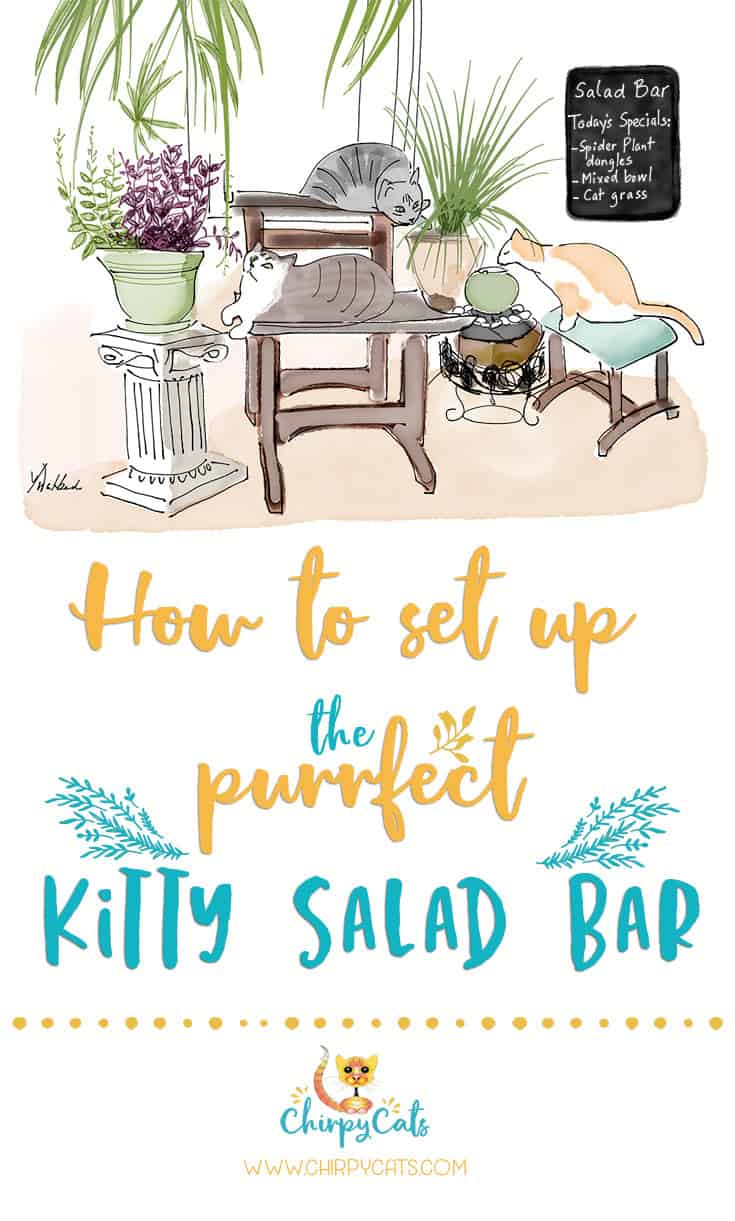How to Prepare the Perfect Kitty Salad Bar
Last updated September 30th, 2019
There are many ways in which you can keep us kitties safe and entertained but we would like to talk about our favorite cat-safe plants, grasses, and herbs. Yes, we’re obligate carnivores but there’s not a cat in town that doesn’t like to graze on greens. Experts and veterinarians are still baffled as to why we enjoy eating grass and theories abound. Some experts think we eat grass to aid in bringing up furballs, or in the wild, to aid regurgitation of undigested parts of prey such as bones and feathers. Others think it provides much-needed fiber to our diets and that grass would be a naturally occurring substance in the stomachs of prey so it would make up a small part of our diet. It may also provide trace elements of vitamins and folic acid. The Lady Cat thinks we may just like the taste and texture. But what is certain is that grass is not essential to our wellbeing, but it most certainly is a welcomed treat in any cat household.
With the start of Autumn and the cooler weather, we’re excited that the humans have begun setting up our watering hole/salad bar for winter. Essentially, this is when they bring the outdoors, indoors for the duration of the winter, during which time our catio is a blanket of white. The kitty salad bar is an area in the house where we like to lounge, groom, drink, share sun puddles and snack on our greens. There are many plants that appear on the toxic list and it seems that there are no safe alternatives for us cats. Cat grass and catnip are the most popular snacks on the menu, but I’m here to tell you that you can broaden your tastes and that there are indeed many other safe varieties of plants that us Chirpy Cats have tried and tested. Of course, our plant-eating habit comes with leaving a few recycled remnants of regurgitation on the carpet, but fret not humans. Cleaning it all up is a very small price to pay for the precious purr therapy we provide to soothe your stressful living. By creating these little kitty garden watering holes around the house, you’re stepping up your cat environment enrichment game. Below, our big lady cat explains further on greening up our living spaces and tips on keeping us out of your plants. (as if!)
Love
Sarabi, the old lady Bengal cat
The kitty Salad bar and Watering hole
Providing cats with their very own lounging area with a variety of cat-safe plants to chew on, is a great way to mimic the natural setting of what cats would normally encounter in an outdoor garden. A little nibble here, a sip there, perhaps a catnap for the afternoon? Your indoor cat will welcome it.
This post contains affiliate links, which means if you make a purchase when clicking a link I will make a small commission which helps maintain this blog (and the Chirpies’ weekend catnip habit too!) but won’t cost you a cent more! Read my full disclosure.
Where to set up the kitty salad bar
The ideal spot for the cats’ salad bar is somewhere near a South-facing window that gets a good sprinkling of sun puddles throughout the day. This is ideal in a multi-cat household where different cats will be time-sharing the same spot throughout the day. Even if your cat is not a lap cat, they still like to be in close proximity to their humans. So make sure the location is not hidden in some secluded spot where there is no human activity. The Chirpy Cats’ watering hole consists of a two-tiered kitty bar stool with cat-safe plants on either end. It is situated in the kitchen, next to a sunny south-east facing window in a high traffic area. It’s also the Big Man Cat’s office during the day, so he’s in good company. Free purr therapy on the job!
Things to consider when setting up the kitty salad bar:
- Arrange your plants on sturdy platforms so that there is little risk of being knocked over by over-zealous zoomies sessions. Multi-tiered plant stands are ideal, but ensure that they are secure and do not tip over easily.
- A pet water fountain placed in between the plants is a great feature to add to your kitty’s watering hole and also encourages drinking. I always notice my cats immediately heading towards the water after a catnap or grazing session. During winter most heated indoor environments are dry in winter and the fountain also acts as a mild humidifier for the plants around it. Ensure that the water is always fresh and change filters regularly.
- If you have space for more plants, double up on a kitty favorite. I know that our cats go for the Carex grasses and spider plants, so I have these in abundance which I bring inside for the winter. I place them at various levels so that it’s easily accessible to multiple cats.
- Spider plants can be placed directly overhead the watering hole in hanging baskets as well as on lower levels in pots placed on plant stands. This plant has a two-fold function. With its attractive variegated foliage, the spider plant is known for its air-purifying qualities, a fantastic choice for the indoor environment (see NASA’s study on plants for indoor air pollution). The cats like the taste of the spider plant and the long dangling spiderettes (spider plant babies) which grow outwards, provide a little amusement for kitties. Spider plants are said to have a subtle hallucinogenic effect on cats, similar to catnip, but this effect is completely harmless.
- Very important: Even though a plant may be listed as non-toxic, always watch for over-indulgence. Any plant eaten in excess may cause upset stomach and diarrhea, and if your cat seems to gravitate towards one particular plant a little too often, perhaps it’s best to elevate the offending plant or remove it from the snack menu altogether.

Spider plant crunchies taste the best

Hey there, this is where we hang out

Cats only, do you have a valid pass?
Plants Toxic to cats
I know quite a few people who have said that they cannot keep plants in the house due to concerns about plant toxicity. The ASPCA has an exhaustive list of plants that are toxic to both cats and dogs, with varying degrees of toxicity from mild stomach upset to death. Many of the listed toxic plants have not all caused illness, but are listed anyway, if it happens to be in the same family or genus of a known offender. There are many plants that sometimes share the same name with a toxic plant but are not toxic themselves. All very confusing! First in Flowers has an easy to read breakdown of plants that vary in their toxicity to cats and should be avoided.
Plants and herbs that are safe include:
I love this list of safe plants for cats, dogs and your two-legged kids from the Laid back gardener, many of which I have in my home. A word of caution: It’s always a sensible thing to observe your cat if you are introducing a new plant, even if it’s on the safe list. Cats or any animal can choke on leaves. I have had no incidences other than the lovely regurgitated present left on the kitchen floor. (^-^)/ My cats generally go for plants with grass-like leaves and leave the succulents alone.
Plants for the Kitty Salad Bar:
- Spider Plant
- Polka Dot Plant (does not mind shade but keep away from heat)
- Catnip (best grown outdoors in full sun, but still worth a try indoors)
- Oat Grass
- Wheat Grass
- Carex
- Basil
- Dill
- Celery
- Parsley
- Coriander
- Watercress
- German Chamomile ((Matricaria chamomilla) NOTE: English Chamomile is toxic to cats
Other household plants safe for cats (present in our home):
- Boston Ferns
- Money Tree
- Lemongrass
- Iresine Purple Lady
- Orchids
- Swedish Ivy
- Ming Aralia
How to keep your cats from eating your houseplants
We have a money tree and a Cordyline plant next to their watering hole and Jimmy likes to test the waters and tries his luck at chewing the leaves. The kitty salad bar should keep your cat from munching on your other household plants, but if you have a persistent little grazer on your hands, like our Jimmy, here’s what you can do:
- Spray some bitter apple on the foliage of your plant where little paws can reach. Test on a small piece first, especially for sensitive plants.
- Mix water and lemon juice in a spray bottle and spray the foliage. You can also try a few drops of citronella oil mixed in water and use this to spray the plant – cats don’t like citrus and will literally turn up their noses if you flash a lemon under their noses – a good deterrent. Sometimes I leave a few pieces of sliced lemon in the pot plant and this has worked wonders.
- If all else fails, simply elevate your plants on higher plant stands or put them in hanging baskets. I have a mother-in-law’s tongue, also know as the Snake plant (Sansevieria trifasciata) and this plant could cause upset stomach and diarrhea in cats and dogs, so it’s completely off-limits to our cats. I keep this plant in our bedroom as it is one of the top air purifying plants which give off oxygen at night and aids a good night’s sleep.
- Lastly, let’s not forget that we can always rely on our trusted cat herb, the good ‘ol nip. Sprinkle catnip on the plants at their watering hole and this is sure to make them keep coming back for more.
- Keep a can of coins handy and shake it whenever you see a grazer at your plants. What was that noise, let’s keep away!
Have you set up your indoor kitty watering hole for winter? If you know of any other plants or herbs that can be included on the safe list please let us know in the comments below.
I leave you with a video of one of our first kitty salad bars. I hope you enjoy it!
Follow our stories and inspiring DIY cat hacks on Facebook, Instagram, Twitter and Pinterest
For more inspiring ways to your cat’s heart, sign up free to our pawsome newsletter and stay updated on DIY cat hacks and enrichment ideas.
[madmimi id=866506]




Excellent post. Whenever my cats get in the dining room they go for the spider plant,good to know they are safe.
Glad you liked it and yes, isn’t it cool to know? According to the University of Wisconsin-Madison News, these plants contain chemical compounds related to opium, and they explain that that could be a possible reason why they are attracted to it. I wish there was more research about it ?
Great post! Love the art 🙂
Thank you! ?
MeOoooooW We would luv, luv, luv a kitty salad bar. Da bestest we can get mommy to do is a small pot of grass. MOL Great posty, fanks fur sharin’.
Luv ya’
Dezi and Raena
Thank you Dezi and glad you liked the post. We will surely protest in subtle and not-so-subtle ways if the human does not arrange our winter watering hole. MOL ?
A kitty salad bar ? What a smart idea ! Great post ! Purrs
Thank you, it’s fun and always nice to try new arrangements each year!
This post is just fantastic! A salad bar is an amazing idea for our indoor kitties…I just wish I didn’t have such a black thumb!
Glad you liked it! Actually, spider plants are very hard to kill, so give it a try! They are also easy to propagate so you can make many smaller plants in little pots. A good idea anyway, since the cats will ‘prune’ them continuously so nice to have fresh ‘salad’ at hand. Also smaller pots can work with spider plants as they don’t mind being root bound. When they start getting bigger and the foliage starts sending our little hanging spiderettes, you can repot them into hanging baskets and the cats will amuse themselves with these. So I have a combination of hanging ones, as well as ones on the ground in smaller pots.
P.S. I always thought I had a black thumb, but that was all in my head 🙂
OMG, you kitties have the best forever home. An awesome catio…a wonderful salad bar! My kitties are asking when they can come visit?!?
Thank you :0) We can always arrange a play date MOL!
[…] with our catio decor. We will definitely be bringing this inside in late Fall when we set up the cats’ indoor salad bar for […]
Thanks for the great information!
One thought: PLEASE include the Latin name for each plant you recommend. Always!
Many plants share the same “common” name, and some get mis-named as well. There are several plants called “money plant,” for example, and quite a few are not safe for cats to eat. Although some people may think using a Latin name is being “snooty,” it really is the only way to make certain it’s the plant you need.
I live in a small town, and neither the grocery store nor “big box” store offer a wide variety of houseplants. But the local floral shop owners will special-order a particular plant, and I always give them the Latin name. Then we are both happy, and I can be sure my cats won’t be harmed.
PS It’s a good idea to wash the leaves and stems of new plants before your cats are introduced to them. Some nurseries use sprays that aren’t good for cats to eat.
Your cats looks so cute and funny haha, just looking by it making me lough here.